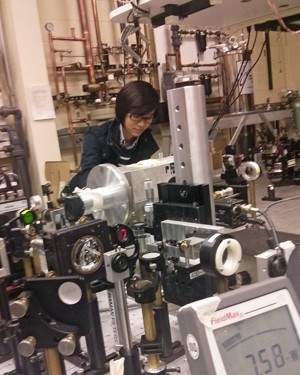
Physics in 3-D? That's nothing. Try 0-D
In physics, there's small, and then there's nullity as in zero-dimensional.
University of Cincinnati researchers have reached this threshold with a special structure that may someday lead to better ways of harnessing solar energy, stronger lasers or more sensitive medical diagnostic devices.
These structures are semiconductor nanowires. UC doctoral student Teng Shi says she and a team of researchers have observed unique optical signatures indicating that electronic excitations within these nanowires can be confined to a zero-dimensional state called a "quantum dot."
This latest discovery is all about going small, but its significance is anything but. The research teams ability to
control the confinement energy by varying the size of the quantum dot opens up a world of possibilities
.
"Exploring the basic physics of semiconductor nanowires enables one to envision applications or to design structures for applications," says Shi of UC's
. "These structures are potential candidates for a variety of applications including photovoltaics, lasers and ultra-sensitive nanosensors."
Shi will present the team's research "
Temperature-dependent Photoluminescence Imaging of GaAs/AlGaAs Heterostructure Quantum Well Tubes
" at the
American Physical Society (APS) meeting
to be held March 3-7 in Denver. Nearly 10,000 professionals, scholars and students will attend the APS meeting to discuss new research from industry, universities and laboratories from around the world.
This research advances
work previously done on semiconductor nanowires at UC
. By using a thin shell called a quantum well tube and growing it to about 4 nanometers thick around the nanowire core, researchers found electrons within the nanowire were distributed in an unusual way in relation to the facets of the hexagonal tube. The result is a quantum wire, like a long string many times thinner than a human hair.
Now they've taken things even further, going from one-dimensional wires to zero-dimensional quantum dots.
These little structures could have a big effect on a variety of technologies
. Semiconductors are at the center of modern electronics. Computers, TVs and cellphones have them. Theyre made from the crystalline form of elements that have scientifically beneficial electrical conductivity properties. Many semiconductors are made of silicon, but gallium arsenide is used in this research.
Additional contributors to this research are UC physics professors Howard Jackson and Leigh Smith in the
McMicken College of Arts and Sciences
; Jan Yarrison-Rice of Miami University; and Nian Jiang, Hoe Tan, Qiang Gao and Chennupati Jagadish of Australian National University.
The team at UC is one of only about a half dozen in the U.S. conducting competitive research in the field, and UCs efforts in this area are partially funded by the National Science Foundation. The team's big achievements in the science of small support the
by producing new ways of understanding and transforming the world through research and scholarship.
Related Stories
UC offers experiential learning abroad in Central America
April 19, 2024
In the tropical paradise of Costa Rica, fourth year journalism and international affairs student Stephanie Rivera embarked on an unforgettable journey of self-discovery and cultural immersion. Leaving behind the familiar sights and sounds of Cincinnati, Rivera set out to study abroad for a transformative semester in this Central American country, rich with vibrant biodiversity and cultural heritage. The College of Arts & Sciences (A&S) at UC places great emphasis on encouraging study abroad and experiential learning opportunities for its students. Recognizing the transformative power of global experiences, the college supports a variety of study-abroad programs that enable students to enhance their academic pursuits while gaining valuable cultural and personal experiences.
WVXU: Test your word puzzle skills with a Cincinnati...
April 18, 2024
Cincinnati edition host Lucy May discusses the history and new found popularity of word games with Michael Griffith, professor English. Griffith is a writer, but also develops word games for publication.
Jason and Travis Kelce take Cincinnati to ‘New Heights’
April 16, 2024
UC alumni Jason and Travis Kelce returned to UC for an unforgettable evening that included the Great "Lombaby" Games, a live recording of their podcast "New Heights," special guests Joe Burrow, Orlando Brown Jr. and Desmond Ridder and a surprise commencement ceremony.
